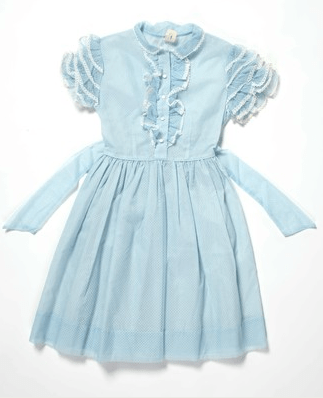
The new Kiwi Chicks exhibition has provided the opportunity to show off some of Te Papa’s childhood collection, in many cases for the first time. There are some real gems crying out to be seen, including a collection of 1950s dresses that were acquired in 2011.
The wonderful thing about this collection are the many stories that come with it. Most of the dresses were home-made and represent a time when a home-made dress was the only way to keep up with the latest fashion. Most girls learnt to sew at school and the girls who wore these dresses, Shelley and Maureen O’Brien, could both sew their own clothes by the time they were teenagers. Even so, most of the dresses in this collection were made by the girls’ grandmother, Winifred O’Hara, known as Wini.
Wini and the girls’ mum always chose the styles and fabrics, never Maureen or Shelley themselves. This was done during their biannual trip to Wellington. The family lived on a farm in Tinui in the Wairarapa so it was a real mission to get there. The day began at 4am so they could make it in time for the 7am workers’ train. Visiting town also involved fun stuff for the kids—the zoo, museum or the Botanic Gardens.
Some of the dresses came from Auntie Nancy in America, though they weren’t necessarily the most loved. Shelley hated the blue frilly one – she preferred simple straight cut styles. Aunt Nancy’s story is an interesting aside. She married an American marine who was stationed in Masterton during World War Two. During the war, there were up to 45,000 American service men living in camps throughout New Zealand, so of course many romances ignited. The couple went to live in America after the war and every year Nancy sent a Christmas parcel with new and second-hand clothes for Maureen and Shelley.
The dresses also provide an opportunity to explore the everyday lives of the children growing up in rural New Zealand in the 1950s. I can imagine the young girls running about in their pretty dresses on a hot summer’s day. While they had fun, there were tough times too. The war had taken its toll on the children’s father and he had difficulty tolerating the noise of howling farm dogs and children playing. He was a private man who was prone to violent, aggressive outbursts that often affected the family.
The kids were all expected to do jobs and help out on the farm. When the sheep were mustered for shearing, drenching, dagging (crutching) or weaning, the children all helped. Shelley explained that they had to be the ‘good dogs’, which meant knowing which way the sheep might make a break for it and get there first, ‘We helped in the yards and in the shearing shed. I still remember the smell of the foot-rot trough which made the eyes sting.’
There are many other stories associated with these dresses – stories that girls can relate to, both in New Zealand and around the world, growing up in the 1950s or today. Along with the rich history they evoke, the dresses can be also be enjoyed for their shear retro appeal and for making life just a little bit more pretty.
-Lynette Townsend
Curator History
Te Papa Tongarewa
